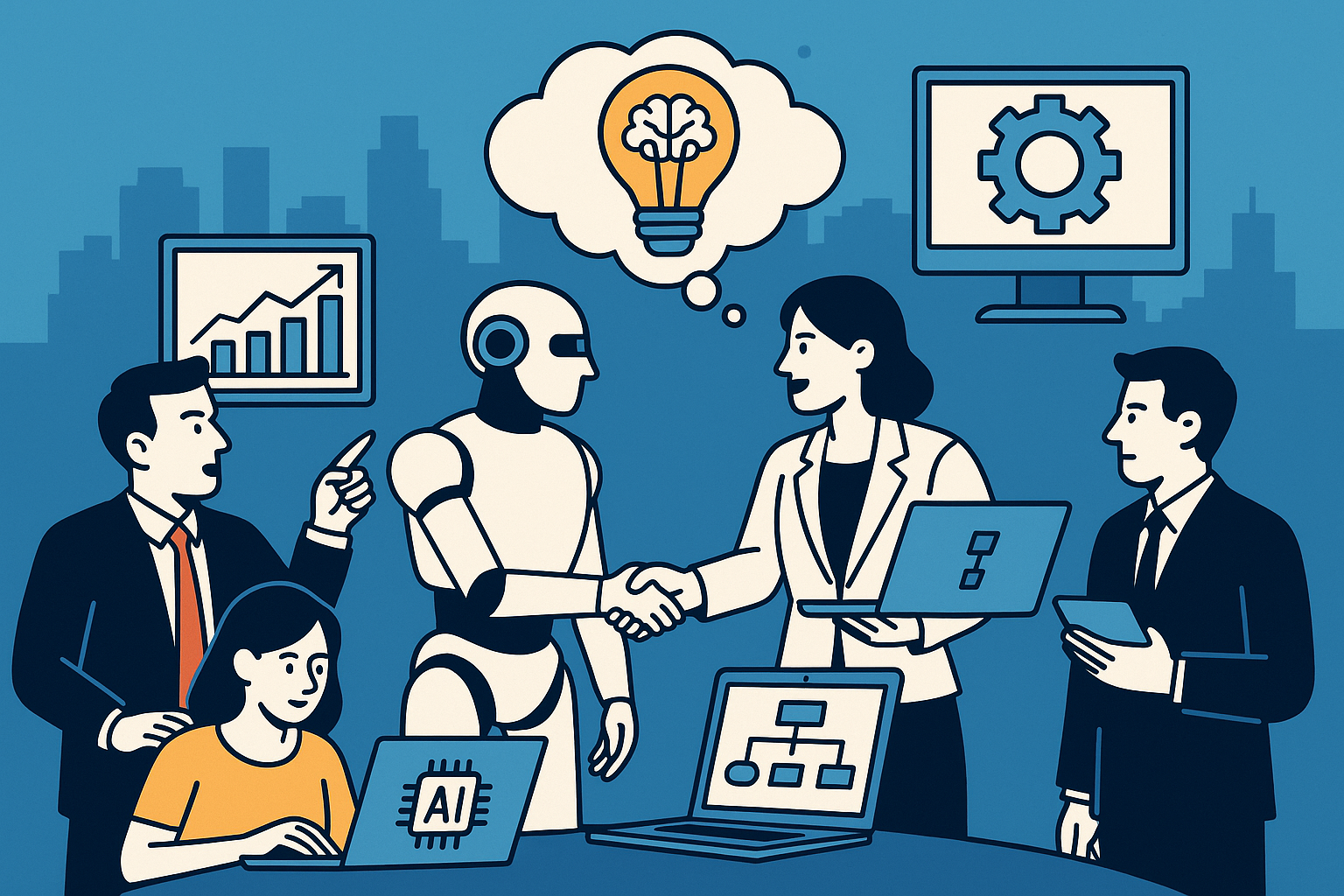Redesigning Business Models with AI Agents and Virtual Delivery Centers

While generative AI continues to dominate headlines, the rise of AI agents represents an inflection point for enterprises. These autonomous or semi-autonomous digital workers are no longer confined to operational assistance; they are now poised to rewire the very architecture of modern business models. Gartner predicts that by 2028, 33% of enterprise software applications will embed agentic AI, with at least 15% of day-to-day decisions made autonomously.
But this shift isn’t simply about plugging AI agents into workflows. It’s about aligning strategy, customer experience, and digital infrastructure to support entirely new value creation models. And to do that, organizations need a new operational model: the Virtual Delivery Center (VDC).
Traditional uses of AI focused on optimization—reducing human workload, streamlining operations, automating decisions. But AI agents bring a deeper promise: enabling enterprises to reimagine their business models.
Business model innovation is not a tech-first initiative; it is customer-first. AI agents become valuable when deployed against clear customer journey pain points—friction in onboarding, delays in order fulfillment, gaps in personalization, or lags in service recovery. Agents can operate 24/7, predict behaviors, and respond with agility at scale.
For example, a telecom operator could deploy AI agents to proactively resolve service disruptions before customers even detect them. A bank could build agent-powered financial assistants that monitor spending, recommend savings products, and engage with clients autonomously. These are not just automations; they are new revenue streams.
The strategic deployment of AI agents requires more than implementation. It requires orchestration. Organizations should follow a six-step framework:
Define Goals: Start with business outcomes. Are you trying to cut costs, increase conversion, or launch a new service model?
Map the Customer Journey: Identify all touchpoints—digital and physical—across channels.
Pinpoint Pain Points: Where are delays, inefficiencies, or dissatisfaction occurring? Let data guide you.
Design Agentic Solutions: Map agent types to problems. Use goal-based agents for proactive problem-solving or collaborative agents for internal handoffs.
Manage Change: Build a culture of trust around AI. Prepare teams to work alongside digital agents.
Evaluate Continuously: Track real-time KPIs. Train your agents with data feedback loops for constant improvement.
This isn’t a linear roadmap. It’s a cyclic, iterative playbook enabled by agile deployment.
AI agents vary widely in their capabilities. Leaders must understand this spectrum to avoid misalignment:
Reflex agents: Respond instantly to stimuli (e.g., traffic rerouting bots).
Goal-based agents: Make decisions that align with end objectives (e.g., lead prioritization bots).
Learning agents: Improve over time based on feedback (e.g., HR onboarding agents).
Utility-based agents: Balance trade-offs to maximize outcomes (e.g., supply chain optimizers).
Hierarchical agents: Manage sub-agents or orchestrate workflows (e.g., insurance claims coordinators).
Collaborative agents: Work across departments or organizations (e.g., AI-based project managers).
And increasingly, enterprises are exploring LLM-powered agents that combine reasoning, language, and planning in powerful ways. These agents don’t just execute—they understand.
As promising as AI agents are, most enterprises lack the in-house capabilities to build, integrate, and manage them at scale. This is where the Virtual Delivery Center (VDC) becomes critical.
A VDC is not just a team. It’s an operating model. It brings together:
Pre-vetted AI and agent development experts across design, training, deployment, and governance.
Composable architecture frameworks that allow rapid integration into legacy and cloud systems.
Agile squads that continuously test, deploy, and retrain AI agents using real-time business data.
Security and compliance by design to prevent rogue agent behavior or data leakage.
Through a VDC, organizations can launch pilot programs in weeks, scale proven agents in months, and iterate continuously—all without overburdening internal teams.
Let’s examine how businesses are already deploying AI agents through VDC models:
Retail: A global brand used AI agents to manage promotions and customer queries during peak season. With a VDC, they deployed multilingual LLM agents in 12 markets in just 45 days.
Healthcare: A network of clinics integrated scheduling agents that reduced no-shows by 22%. The VDC built secure integrations with EHR systems and handled all compliance auditing.
Logistics: A supply chain company deployed utility-based agents to dynamically reroute shipments. The VDC provided the simulation environment to test trade-offs in advance.
B2B SaaS: A tech startup used learning-based agents to onboard customers, answer FAQs, and push usage insights—with content continuously refined by the VDC based on user behavior.
These use cases are not about replacing humans. They’re about orchestrating human-machine collaboration.
LLM agents (powered by GPT, Claude, or open-source models) bring unprecedented reasoning and language skills. But they require precise design:
Prompt Engineering: Modular prompts must be templated and context-aware.
Planning Algorithms: Combine language output with symbolic planning to execute multi-step tasks.
Tool Use: Agents should be equipped to invoke APIs, databases, or enterprise tools (e.g., CRMs).
Memory & State: Design memory architecture for continuity and personalization.
Guardrails: Implement rejection sampling, output monitoring, and fallback workflows.
The VDC team excels in building these modular, robust, and adaptable LLM agent systems that evolve over time.
Autonomous agents introduce new governance challenges. Enterprises must implement robust policies:
Explainability: Users must understand how agents make decisions.
Bias Audits: Regular assessments must be performed, especially for customer-facing agents.
Data Usage Policies: Ensure agents don’t inadvertently store or leak sensitive data.
Fallback & Override: Always allow human override, especially in regulated domains.
Continual Learning: Define protocols for retraining and model updates.
The VDC acts as the control tower, embedding governance into the development lifecycle—not as an afterthought but as foundational design.
Some of the most powerful applications of agentic AI involve not a single agent, but a system of interacting agents. MAS systems enable:
Task decomposition: Breaking a workflow into subtasks, each managed by a specialized agent.
Role coordination: Agents play roles (e.g., procurement, finance, logistics) and negotiate among themselves.
Redundancy & robustness: Failure of one agent doesn’t stall the system.
Imagine a virtual enterprise with a dozen agents simulating and optimizing business scenarios in real time. That’s where the VDC model becomes essential—to architect, test, and monitor such complex ecosystems.
We’re entering an era where value will be created not just through people or platforms but through persistent, intelligent agents embedded across the enterprise. And to implement them with precision, scale, and speed, businesses need more than consultants—they need a Virtual Delivery Center.
Just as cloud platforms revolutionized infrastructure and agile transformed software, AI agents + VDCs will redefine how businesses operate, compete, and grow.
The time to build that capability is now.

By redesigning packaging, exploring reusable models, investing in smart tracking, and leveraging the VDC model for execution, beverage manufacturers can reduce their environmental footprint while boosting their brand relevance and operational resilience.